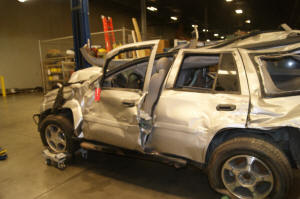Special Report: Suit over deadly crash renews spotlight on GM safety
practices
 Send a link to a friend
Send a link to a friend
 [March 17, 2021]
By Mike Spector and Benjamin Lesser [March 17, 2021]
By Mike Spector and Benjamin Lesser
NEW YORK (Reuters) - On a clear afternoon
in November 2014, Glenda Marie Buchanan set off in her silver Chevrolet
Trailblazer SUV from her home in rural Georgia. Several minutes into the
drive, she started veering off the road. Buchanan swerved left and lost
control, and the vehicle rolled onto its side into a ditch.
The 42-year-old mother and Home Depot saleswoman died in the crash. The
cause, her widower alleges in a lawsuit, was a defective steering sensor
that the vehicle’s manufacturer, General Motors Co, failed to adequately
warn drivers about despite long knowing the component had issues.
The sensor’s failure disabled the 2007 Trailblazer’s electronic
stability control, a significant safety feature designed to prevent
crashes, according to the lawsuit, which was filed in a local Georgia
court in 2016 and updated in 2020. GM, the top-selling automaker in the
United States, denies the allegations.
The case renews a spotlight on GM’s safety practices, seven years after
the Detroit automaker vowed never to repeat a notorious failure to
recall millions of vehicles with defective ignition switches later
linked to 124 deaths. The ongoing litigation alleges that GM long
concealed problems with the steering sensor that risked creating
dangerous conditions for drivers, even after an internal investigation
uncovered issues with the component.

A Reuters review of hundreds of pages of documents submitted in the
Buchanan litigation shows that GM has since 2007 confronted a series of
issues with the steering sensor, including high levels of warranty
claims and a manufacturing flaw, without recalling affected vehicles.
Buchanan’s case is the only one Reuters has identified in which a death
is alleged to have stemmed from a failure of the steering sensor.
Many of the key documents Reuters reviewed, including depositions taken
of GM employees and findings from an internal GM probe in 2018, are
filed under seal or otherwise shielded from public view under a Georgia
judge’s sweeping protective order. Their contents are reported here for
the first time.
The 2018 GM investigation into the steering sensor was launched after
evidence in the Buchanan case suggested a problem with the component in
her car. That probe found more than 73,700 warranty claims related to
the part, according to a GM document and the deposition of a company
employee. The documents don’t detail the specific issues raised in the
warranty claims. GM declined to comment on the claims.
The number of claims is equal to about 10% of the roughly 778,000 SUVs
GM manufactured with the sensor between 2006 and 2009. Car companies
usually expect a rate of defects or other problems among vehicle
components closer to a fraction of 1%, according to industry advisers.
About a half a million vehicles containing the component remain on U.S.
roads, according to 2019 registration data from digital automotive
marketing firm Hedges & Company.
GM decided against recalling vehicles after the internal probe found it
inconclusive as to whether electronic stability control was inoperative
at the time of Buchanan’s crash, according to employee testimony
reviewed by Reuters. The probe made no determination on whether the
sensor was defective.
The sensor is a key part of GM’s version of electronic stability
control, called StabiliTrak. Like other such systems, StabiliTrak
adjusts brakes and engine power to help drivers avoid losing control and
crashing.

Both GM and regulators have lauded electronic stability control as among
the most significant automotive safety features since the seatbelt. A
2007 U.S. safety regulation has made the life-saving feature mandatory
in almost all new vehicles since September 2011. It saved more than
7,000 lives during the five-year period from 2011 to 2015, according to
regulators.
The primary U.S. vehicle safety regulator, the National Highway Traffic
Safety Administration (NHTSA), told Reuters it reviewed concerns raised
by Lance Cooper, the lawyer representing Buchanan’s widower. In a
February 2020 letter to NHTSA, Cooper urged regulators to investigate GM
for failing to disclose the allegedly defective steering sensor in a
timely manner and recall affected vehicles. Cooper previously unearthed
evidence in another case that helped set off GM’s ignition-switch
crisis.
But NHTSA said it decided in late January against opening an
investigation. That previously unreported review included confidential
documents related to the litigation that GM provided to the agency in
March of last year, in response to an informal request for information,
according to court documents.
The NHTSA review “determined there was insufficient evidence to lead to
a formal investigation at this time,” the agency said, adding that it
would take future action if warranted. The agency noted that the SUVs
containing the steering sensor were built before almost all new vehicles
sold in the United States were required to come equipped with electronic
stability control.
In written responses to questions from Reuters, GM said that after the
ignition-switch crisis, it “comprehensively rebuilt and strengthened its
product safety processes.” That includes encouraging employees to
elevate concerns, the company said. GM also underwent several years of
extra oversight from regulators. It declined to comment on NHTSA’s
decision to not open an investigation.
Asked about the alleged issues with the steering sensor and GM’s
decision to not recall vehicles, the automaker said it had conducted
thorough investigations involving experts across many disciplines. After
“a rigorous analysis of internal and external data,” the company said,
“we’re not aware of any other complaints alleging accidents,” aside from
Buchanan’s, that involve StabiliTrak disengaging due to a faulty
steering sensor.
The sensor-related data scrutinized in GM’s 2018 investigation included
the warranty claims as well as three other legal claims and more than
5,800 complaints from dealers and customers. GM declined to comment on
the complaints and the volume of claims.
On the Buchanan crash, GM said that a warning light in the vehicle had
flashed hundreds of times before her fatal journey, indicating service
was required. Current and former GM employees testified that even after
losing StabiliTrak, drivers can still steer and brake, so vehicles
remain safe.
GM, in a court filing, has denied that the sensor in Buchanan’s vehicle
failed and disabled StabiliTrak. Buchanan was texting minutes before the
crash on a dangerous roadway replete with winding curves and narrow
shoulders, GM said in another court filing. Buchanan was also driving
five to 10 miles-per-hour above the posted speed limit, GM said in the
court filing, pointing to testimony of a woman who was driving behind
her for several miles before the crash.
The widower’s lawyer, Cooper, countered GM’s account of the crash in a
court filing, saying phone records show she wasn’t texting at the time
of the wreck and disputing that the road was dangerous. Cooper told
Reuters that the Trailblazer’s black box did not record her speed.
GM is fighting an attempt by Cooper to depose its chief executive, Mary
Barra. In a sworn affidavit, Barra has said she knew nothing about the
automaker’s inquiry into the steering sensor. Barra, via the company
spokesman, declined an interview request.
GM noted the vehicles containing the component were built more than a
decade ago. The GM models containing the steering sensor are the
2006-2009 Trailblazer and GMC Envoy; 2006-2007 Buick Rainier; 2006-2009
Saab 9-7x; and 2006-2007 Isuzu Ascender, according to court records.
“DEJA VU”
Two former heads of NHTSA questioned GM’s decision not to launch a
recall. They told Reuters they would expect a vehicle manufacturer to
conduct a recall when presented with evidence of high warranty claims
related to the same component, such as those GM found with the steering
sensor, and a condition that risks disabling a key safety feature like
electronic stability control.
The two former NHTSA heads also questioned the agency’s decision not to
open an investigation. One of them is David Friedman, who was acting
head of NHTSA during GM’s ignition-switch crisis. Friedman said he would
have expected the agency to do more because the technology, even if not
required, was well on its way to becoming mainstream when the affected
vehicles were built. GM began including StabiliTrak as a standard
feature in the Trailblazer and other similar SUVs in model year 2006,
five years before it became mandatory.
“Taking it away makes the car more dangerous, and that’s likely an
unreasonable risk to safety,” Friedman said, adding that he believed it
warranted further investigation. “Imagine if your seatbelts, before
seatbelts were required, didn’t work.”Cooper expressed disappointment
with NHTSA’s decision, saying the risk of sensor failure “unquestionably
relates to automotive safety.”
NHTSA said it reviewed all available data “for severity of outcome and
verified frequency of occurrence” related to the sensor before deciding
not to pursue a formal probe. The agency said it would continue to
monitor complaints and other data.
[to top of second column]
|

The wrecked 2007 Chevrolet Trailblazer that resulted in a lawsuit
renewing a spotlight on General Motors Co's safety practices is seen
in this undated handout photo in Marietta, Georgia, U.S.. Lance
Cooper/Handout via REUTERS.

GM said it reported Buchanan’s claims to NHTSA after the lawsuit was
filed in 2016 under legal obligations requiring automakers to
disclose the existence of such incidents and allegations.
U.S. law requires car companies to alert regulators within five days
of discovering a vehicle defect that poses an unreasonable safety
risk, which includes conditions increasing the chance of a crash or
a component malfunctioning that could harm consumers. Manufacturers
must then recall affected vehicles.
The maximum fine for compliance failures is about $100 million, a
small fraction of the billions of dollars in annual sales for many
large automotive companies. Criminal liability for failing to
disclose a safety defect is limited under federal law, so
prosecutors looking to bring charges usually need to pursue other
allegations, such as illegal coverups or fraud.
Regulators cracked down seven years ago on automotive companies
skirting legal requirements to disclose safety risks. Yet
manufacturers still have significant leeway in deciding how to
address concerns in vehicles, including whether a problem is serious
enough to launch a recall, according to industry advisers and former
U.S. officials.
The term “defect” is not narrowly defined under U.S. law, leaving it
open to debate, including over the likelihood of a problem harming
drivers. But even a remote chance of injury can trigger recalls,
industry advisers and former U.S. automotive safety officials said.
GM has in the past recalled other vehicles with conditions that
risked disabling electronic stability control.
Cooper told Reuters that GM’s approach to the alleged sensor issues
drew parallels with the automaker's years-long scramble to make
sense of concerns related to vehicles with defective ignition
switches before launching a recall.

“It’s deja vu,” Cooper said.
GM previously admitted it kept regulators and consumers in the dark
about the faulty ignition switch despite clear internal evidence it
could lead to dangerous airbag failures. In 2015, GM resolved
criminal charges stemming from the lapse in a deferred prosecution
agreement. In its responses to Reuters, the automaker rejected
Cooper’s ignition-switch comparison and said concerns raised in the
Buchanan case were subjected to “robust” investigation.
The component at issue monitors the steering wheel’s position and is
part of the StabiliTrak system. According to a Reuters analysis of
NHTSA consumer complaint data, regulators have received more than
100 complaints concerning the sensor or StabiliTrak in vehicles with
the component over the past 15 years. That included one complaint
involving a crash in 2014, alleging StabiliTrak operated when it
shouldn’t have. If electronic stability control activates at the
wrong time, the system could suddenly apply brakes, potentially
causing a driver to lose control of the vehicle.
The complaints include reports of steering sensors malfunctioning,
StabiliTrak warning lights illuminating, and StabiliTrak being
disabled or improperly activating. More than 30 of the complaints
involved consumers allegedly losing control of their vehicles.
A complaint is not dispositive evidence of sensors or StabiliTrak
malfunctioning, however. Complaints often lack key details or have
varying amounts of information, which limits regulators’ ability to
pinpoint specific problems.
GM declined to comment on Reuters’ analysis of the NHTSA data. But
it said its experts usually cast a wide net when reviewing such
consumer complaints early in investigations before zeroing in on
information deemed more precisely related to the issue under
scrutiny. A crash involving StabiliTrak improperly activating is
distinct from allegations in the Buchanan case that the system
disengaged, GM said.
MANUFACTURING ANOMALY
GM began including StabiliTrak as a standard feature in the
Trailblazer and the other similar SUVs in model year 2006.
Issues with the steering sensor soon arose. In 2007 model-year
vehicles, warranty claims related to the component increased to a
high level, according to a February 2020 deposition of Mario
Kennedy, a longstanding GM engineer who worked on electronic
stability control. That increase, in part, prompted a GM
problem-solving team to study the sensor, he said.

Kennedy testified that a batch of steering sensors on the 2007
Trailblazer and other similar vehicles had a “manufacturing
anomaly.” The nature of the anomaly is unclear from Kennedy’s
testimony because the transcript reviewed by Reuters is heavily
redacted. But he said GM fixed it.
Kennedy, now retired from GM, couldn’t be reached for comment.
Cooper told Reuters the anomaly related to improper metal coating
applied to the sensor. An expert for Cooper has since determined the
coating problem likely didn’t affect Buchanan’s sensor, though it
hasn’t been ruled out, the lawyer said.
In 2008, several wiring-related issues contributed to high levels of
warranty claims potentially related to the steering sensor, Kennedy
said in his deposition. GM instructed dealerships on how to fix
them, Kennedy testified.
GM declined to comment on the volume and nature of the claims.
TROUBLE CODE
Glenda Marie Buchanan purchased her previously-owned 2007 Chevrolet
Trailblazer three years before her crash. Her widower said in an
interview that she chose a Trailblazer partly because it was a
bigger, heavier car that they thought would be safe.
On the afternoon of the November 2014 crash, she had been on her way
to pick up a dessert from a nearby house, her widower, Robert
Randall Buchanan, told Reuters. Before the accident, she appeared to
be driving normally, the woman following behind her on the road
testified.
Buchanan was wearing a seatbelt, according to a police report and
her widower’s complaint.
In March 2018, as part of the case, a GM supplier downloaded data
from the vehicle’s electronic brake control module with experts for
Cooper and GM present. It showed the presence of a trouble code that
indicates a malfunctioning steering wheel angle sensor or problems
with electronic signals coming from the component, according to
Kennedy’s testimony and GM.
The supplier that conducted the download, now part of ZF
Friedrichshafen AG, declined to comment.
The code’s presence causes StabiliTrak to deactivate, according to
employee testimony and GM. One reason StabiliTrak disables under
that condition is to prevent it from unsafely activating when it is
not supposed to, according to Kennedy’s testimony and GM.
A few months later, in June 2018, GM opened its internal
investigation. A member of the automaker’s legal department had
alerted colleagues to the Buchanan case via a program its chief
executive created after the ignition-switch crisis to elevate
concerns, according to employee depositions and other documents.
The GM investigator leading the probe, Christa Zilincik, found the
automaker had received 73,711 warranty claims related to the
steering wheel angle sensor as of mid-July 2018, according to her
testimony and a document reviewed by Reuters.
GM’s probe also identified 5,861 complaints from customers or
dealers plus 59 complaints to regulators related to the sensor,
Zilincik testified. The documents don't detail the nature of the
complaints, and GM declined to comment on them.
Two GM committees reviewed Zilincik’s findings and decided against
recalling affected vehicles, she testified. Zilincik couldn’t be
reached for comment.
Dan Sharkey, a Detroit-area automotive industry lawyer who isn’t
involved in the Buchanan case, said GM’s findings could not be
ignored. The volume of warranty claims amounting to roughly 10% of
vehicles built with the component that GM uncovered is "materially
high," he said. "That's enough where you would say, 'We've got a big
problem here.'"
(Reporting by Mike Spector and Benjamin Lesser; Editing by Cassell
Bryan-Low)
[© 2021 Thomson Reuters. All rights
reserved.] Copyright 2021 Reuters. All rights reserved. This material may not be published,
broadcast, rewritten or redistributed.
Thompson Reuters is solely responsible for this content. |